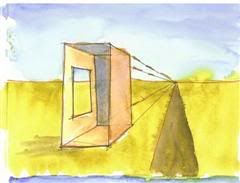This Shabbat coincides with the holiday of Simchat
Torah, the traditional time where we complete the reading of the Torah and then begin it again. We start by reading the end of Deuteronomy
5. So Moses the servant of the Lord died there
in the land of Moab, according to the word of the Lord. 6. And he buried him in a valley in the land of Moab, opposite Beth-Peor; but no man knows his grave till this day. 7. And Moses was one hundred and twenty years old when he died; his eye was not dim, nor his natural force abated. 8. And the people of Israel wept for Moses in the plains of Moab thirty days; and the days of weeping and mourning for Moses were ended. 9. And Joshua the son of Nun was full of the spirit of wisdom; for Moses had laid his hands upon him; and the people of Israel listened to him, and did as the Lord commanded Moses. 10. And there has not arisen since in Israel a prophet like Moses, whom the Lord knew face to face, 11. In all the signs and the wonders, which the Lord sent him to do in the land of Egypt to Pharaoh, and to all his servants, and
to all his land, 12. And in all that mighty hand, and in all the great and awesome deeds which Moses performed in the sight of all Israel.
And then we read the Beginning of Genesis:
1. In the beginning God created the heaven andthe earth. 2. And the earth was without form, and void; and darkness was upon the face of the deep. And a wind from God moved upon the face of the waters. 3. And God said, Let there be light; and there was light. 4. And God saw the light, that it was good; and God divided the
light from the darkness. 5. And God called the light Day, and the darkness he called Night. And there was evening and there was morning,one day.
One if the interesting commentaries on this cycle is connecting the last Hebrew letter of Deuteronomy The lamed in Yisrael, and first letter of Genesis, the beit in Breshit.Together they spell theword leiv, heart. In this connection between beginning and end we do so with our heart. In the biblical text heart was just as much a place of the intellect as an emotional center. But in returning through the cycle in our own lives,Do we do the same?

I had one answer to this question over the weekend. In a restaurant recently I was painting a picture and loved the skirt the hostess was wearing so much I included it in the painting. Usually when painting, I just put a colored background in and don't pay attention much to anything but the subject I'm painting. But I wanted to theme the painting to the skirt and the restaurant, which had a tropical
island theme
 I imagined the woman was on a patio similar to the one I once dined on in Kona, Hawaii at sunset. But that railing looked bad, and detracted for the picture. So I decided to add perspective to my paintings, and that got me thinking too.
I imagined the woman was on a patio similar to the one I once dined on in Kona, Hawaii at sunset. But that railing looked bad, and detracted for the picture. So I decided to add perspective to my paintings, and that got me thinking too.
For those not familiar with those art terms, there are several ways to show depth in art. One, foreshortening, just takes the sizes and shapes of lines as though they were squashed onto a flat piece of glass. Things close are bigger, and things far away are smaller. On the other hand, there is the more geometric variety, known as perspective. Perspective is based on an eye line of the person painting the picture, which usually translates to the horizon line. Along this line are points known as vanishing points, which are the points all lines recede into the distance to meet. 
The simplest variety is one point perspective, where there is one vanishing point, like the one in the illustration of a box with a cut out window. In this case,
all lines converge to one place, like the road and the lines of the box
and window.
But beyond this is the idea of two point perspective, where there are two vanishing points.  As can be seen by the two blocks in the illustration, this is a little more realistic in rendering, yet it is more difficult to do. In this case the vanishing point to the left is not even on the page, and trying to keep all the lines straight is not easy. But still, it looks better than the one vanishing point.
As can be seen by the two blocks in the illustration, this is a little more realistic in rendering, yet it is more difficult to do. In this case the vanishing point to the left is not even on the page, and trying to keep all the lines straight is not easy. But still, it looks better than the one vanishing point.
There are reasons for having three vanishing points, by the way. If we were to put a road between the two blocks in the two point picture, we might use a third vanishing point for the road to follow. Or, if we want to establish height, we might put one perpendicular to the horizon line and shrink the tops of the blocks.
When I added perspective to my paintings, the whole work look far better. The more vanishing points I add, the better it looks, though I find there are more details to consider. How much more so with Torah: every, year, when we read the same thing in the Torah at the same time of the year, we add perspectives and details to our Torah readings and study.
Note that I do not believe we change perspective, but add to our previous ones. Another change which will affect everyone who read Shlomo Drash may help here as another example. Last January, I decided that I wanted Shlomo’s Drash to be on the internet more than my little private e-mail list. So I signed up to Blogger.com, loaded one of their templates, and started blogging my columns. I then
started a website. While my enthusiasm was great at first for the website, my maintenance of it has fallen off during the last few months. As many have probably noted, the holidays section had not changed since Passover! Several projects I had hoped to keep up to date, such as Hebrew, became very difficult to do so.
Part of the problem was I used some automatic tools. For every page I created or changes, I would have to update every other page with changes. This meant that things were very difficult to manage: I even have to edit and post the website, blog, and mail list separately. The automatic tools actually requires more work than doing
the same thing manually. One reason there is no archive of Drashes on the
website is this exact problem, and trying to keep all of this stuff consistently formatted.
However, over the past several days, I learned how to do all this in code (or to use the proper vocabulary, in markup), and understand the underlying structure of a modern web page. I learned funky named markup languages like XHTML and CSS. As I learn, I can do things I could not before, and do them even faster. There will be
plenty of changes to the web site and blog, and hopefully with much better maintenance. By adding viewpoints, and learning new way to use then, the whole of the Web is far clearer to me.
What was cryptic before is no longer, and I can view the world differently because of this. Computer code is strongly literal, with only one layer of meaning. So when we look at something with multiple layers of meaning, such as Torah, how much more so can we see new things with every perspective?
Just in the earliest time of commentary, the Talmudic period, we have plenty of differing perspectives. We have Mishnah, Gemara, Midrash, and Targum, all adding differing views of the texts. Each records differing schools and differing viewpoints. We have later medieval commentators such as Rashi and the Tosafists comprised of his grandsons and their buddies. In the Sephardic world we have Ibn Ezra
and Maimonides. Of course there is the Later Hasidic movement, then Reform, Modern orthodoxy and contemporary commentary. Together they form a whole tool shed of perspective to choose from. Each is a tool to get at meaning we other wise might not decipher.
I try my best to use as many tools a possible, including my own experience in writing these columns. Yet it is all too easy to slip into a pattern of using the same few tools, to the exclusion of others. I’m not the biggest Rashi fan yet, and I’m definitely not the guy to quote Maimonides profusely. There’s a lot I could look at in Hasidic thought as well, but I have often in the last year not gone to those sources, both as a matter of availability of text and expediency of writing this column. Yet, I think it is important to look at all the texts, and not take any as a
final word on the topic. As we will see next week in only one book of midrash, Genesis Rabbah, the perspectives about what happened at the beginning of Creation are numerous. Add other aggadic works, and works from other eras, and you have a massive amount of reading to do.
But every year we need to expand. And some places are difficult to expand into if you don’t know Rabbinic Hebrew. As I learn the nuances of Rabbinic Hebrew, I’m getting closer to the time I can read many of the untranslated stuff out there, and
use those tools to understand the texts. Yet, that is still some time in the future.
Simchat Torah starts with the death of the greatest prophet of all, and ends with the beginning of everything-- all of it done in joy. I’ve had my setbacks lately in teaching Torah, many of the ways outside of the written word I wanted to are as
difficult as ever to do, and to say the least rather frustrating for me. Yet, in 5767, I’m going to be doing a lot of creating, in many different realms. To those who read this, one thing I’d like to do is give you exposure to texts you might not know existed, and give you the perspective on the texts I’ve been using for quite a while. I’m seriously looking into going from print to sound, and figuring out how to get this stuff into a podcast. But most of all, My goal in Shlomo’s Drash is not merely to get something off my chest, though often I do. It’s for everyone to learn more about being a Jew and our rich heritage of perspectives.Mine is by no means the only one, but it is the only one I can give, one which tries to make a lot of intimidating things approachable.
I hope you are as excited about engaging those new perspectives as I am as we journey together.
Hag sameach.







No comments:
Post a Comment